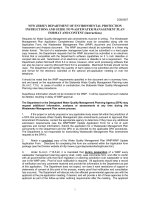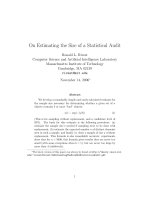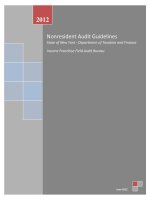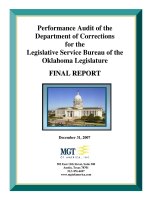New Jersey Department of Education Performance Audit potx
Bạn đang xem bản rút gọn của tài liệu. Xem và tải ngay bản đầy đủ của tài liệu tại đây (3.11 MB, 155 trang )
1
© 2007 KPMG LLP, a U.S. limited liability partnership and a member firm of the KPMG network of independent
member firms affiliated with KPMG International, a Swiss cooperative. All rights reserved. Printed in the U.S.A.
KPMG and the KPMG logo are registered trademarks of KPMG International, a Swiss cooperative. 23177CHI
New Jersey
Department of
Education
Performance
Audit
Final Report
August 2007
KPMG LLP
2
© 2007 KPMG LLP, a U.S. limited liability partnership and a member firm of the KPMG network of independent
member firms affiliated with KPMG International, a Swiss cooperative. All rights reserved. Printed in the U.S.A.
KPMG and the KPMG logo are registered trademarks of KPMG International, a Swiss cooperative. 23177CHI
Table of Contents
Section Page No.
I. Engagement Summary 4
II. Engagement Scope & Approach 10
III. Current State Overview 19
IV. Desired State Overview 53
V. Findings & Recommendations 59
VI. Appendices:
Appendix A – Organizational Chart 157
Appendix B – Job Activity Questionnaire Results 159
Appendix C – District Survey Results 234
Appendix D – Benchmarking Results 289
3
© 2007 KPMG LLP, a U.S. limited liability partnership and a member firm of the KPMG network of independent
member firms affiliated with KPMG International, a Swiss cooperative. All rights reserved. Printed in the U.S.A.
KPMG and the KPMG logo are registered trademarks of KPMG International, a Swiss cooperative. 23177CHI
Section I:
Engagement
Summary
4
© 2007 KPMG LLP, a U.S. limited liability partnership and a member firm of the KPMG network of independent
member firms affiliated with KPMG International, a Swiss cooperative. All rights reserved. Printed in the U.S.A.
KPMG and the KPMG logo are registered trademarks of KPMG International, a Swiss cooperative. 23177CHI
Engagement Summary
Introduction
In 2007, the Senate and General Assembly of the State of New Jersey passed Joint Resolution No. 3 that
indicates the New Jersey Department of Education (DOE) should conduct a thorough and comprehensive
evaluation identifying organizational and staffing deficiencies that limit DOE’s ability to provide effective
oversight of the Districts in the state. In addition, the resolution calls for DOE to improve capacity to oversee
the operation of Districts and to respond immediately and effectively to operational and educational issues
that may arise.
To meet these objectives, DOE commissioned a performance audit to assess the oversight of District
operations and provide recommendations to potentially improve the efficiency and effectiveness of DOE’s
oversight capacity and relevant processes. In furtherance of this goal, KPMG LLP (KPMG) was asked to
provide the requested services so as to offer as an objective and independent assessment of DOE’s
performance in the form of a report. KPMG started fieldwork on May 6, 2007 and concluded on June 29,
2007. DOE was provided a draft report by July 13, 2007. KPMG met with DOE to discuss the draft on July
13, 2007 and throughout the week of July 16, 2007. A final draft was provided by July 27, 2007 as was
required by Joint Resolution No. 3. KPMG conducted this performance audit in accordance with
Performance Audit Standards of Generally Accepted Governmental Auditing Standards as promulgated by
the Comptroller General of the United States (“Yellow Book”).
Engagement Overview, Scope and Approach
A management review of DOE’s current organization was conducted with a focus on DOE’s ability to
implement and execute its District oversight responsibilities including current initiatives, such as the New
Jersey Quality Single Accountability Continuum (QSAC) and Clearing hurdles to shared services; Overriding
waste in schools; Reining in pension abuses; and, Empowering citizens (CORE).
In order to conduct this review, KPMG:
• Conducted interviews with 51 employees from DOE.
• Facilitated three focus groups with County Business Administrators, Country Superintendents, and DOE
recommended attendees.
• Performed a benchmarking review with the states of Arkansas and North Carolina, and the
commonwealths of Kentucky and Massachusetts.
• Conducted a Job Activity Questionnaire (JAQ) Survey of 931 DOE employees, of which 427 completed
the survey.
• Conducted a District Survey of 616 County and District employees, of which 278 completed the survey.
5
© 2007 KPMG LLP, a U.S. limited liability partnership and a member firm of the KPMG network of independent
member firms affiliated with KPMG International, a Swiss cooperative. All rights reserved. Printed in the U.S.A.
KPMG and the KPMG logo are registered trademarks of KPMG International, a Swiss cooperative. 23177CHI
Engagement Summary
Overall Results of Findings and Recommendations
In order for DOE to sufficiently execute its mandated responsibilities, it must have an effective and efficient
operating environment. This environment is founded on the strength of many key elements including:
governance, technology infrastructure, personnel management, financial and budgetary controls,
communication across the organization, and organizational structure. With respect to organizational
structure, it should be noted that DOE was undergoing a transition to a new structure during the course of
the performance audit.
During the audit, we noted key findings in multiple areas which have an organization-wide impact and can
negatively impact DOE’s ability to execute its District oversight mandates and recent initiatives. The findings
were derived from structured interviews, focus groups, document review, surveying and other research. In
order to provide DOE management with a valuable tool to assist in increasing the effectiveness of their
oversight capacity, we classified the findings into two categories; primary – impacting District oversight,
CORE and QSAC directly; and secondary, which encompasses all other findings.
The primary findings include governance; staffing, processes, training, and communication for QSAC and
CORE; and compliance and monitoring.
• The governance findings relate to strategic planning, relationships within DOE, and the organizational
structure of DOE.
• The staffing areas identify issues of inadequate staffing levels and whether employees with additional skill
sets are necessary to support the added responsibilities as a result of the current initiatives.
• The process findings relate to the “how” of executing initiatives such as defining roles and responsibilities
to execute QSAC and CORE at DOE and County Offices. It also includes information regarding the
policies and procedures that relate to the “what” in the execution of the processes.
• The training areas discuss findings related to the training of employees on the current initiatives both from
an implementation and execution aspect and the technical assistance provided by DOE for CORE and
QSAC.
• Communication includes issues around the execution of QSAC and CORE, consistent guidance and
responses to questions, and the dissemination of leading practices in relation to QSAC and CORE.
• The compliance and monitoring finding relates to internal coordination among divisions with respect to
workflow, creation of audit plans, and tracking of trends and findings.
The secondary findings are shorter and more limited in nature and include personnel management,
communication within DOE, budget and finance, and information technology. Please note that the
secondary findings are no less significant, and in some cases, may have a greater impact on an
organization-wide level, most especially for findings related to personnel management and communication.
For a list of the organization of the findings, see page 59. Per the Generally Accepted Government Auditing
Standards (GAGAS), the findings include a criteria, condition, effect, recommendation, and management
response. These terms are defined on page 62.
6
© 2007 KPMG LLP, a U.S. limited liability partnership and a member firm of the KPMG network of independent
member firms affiliated with KPMG International, a Swiss cooperative. All rights reserved. Printed in the U.S.A.
KPMG and the KPMG logo are registered trademarks of KPMG International, a Swiss cooperative. 23177CHI
Engagement Summary
High-Level Summary of Findings
The following is a high level summary of Primary and Secondary findings.
Primary
A. Governance
1. The reporting structure and authority levels between the State Board of Education and DOE
fosters an environment with the potential for competing priorities and inconsistent decision making
processes.
2. The Strategic Plan for Improvement in Public Education in the State of New Jersey is not aligned
with current DOE objectives, goals, and initiatives.
3.1 The new organizational structure was designed and implemented with limited input from key
stakeholders at DOE. Additionally, the new structure did not appear to be sufficiently or
consistently communicated throughout DOE.
3.2 Operational changes as a result of the reorganization have not yet been completed.
3.3 The new organizational structure includes the Office of Abbott Services and Abbott Regional
Offices, and it is not clear how this unit interfaces and relates to the DOE structure.
3.4 The new organizational structure includes the Katzenbach School for the Deaf, and it is not clear
how this unit interfaces and relates to DOE structure.
B. QSAC
4.1 Staffing levels at DOE are not allocated to handle the additional responsibilities of QSAC
implementation and execution.
4.2 DOE lacks an established project team to implement QSAC within the Division of Field Services.
5. The process for implementing and executing QSAC has not been completed and fully formalized.
6. Training and technical assistance in both the interpretation and guidance of QSAC have not been
provided.
7. There appears to be a lack of communication within DOE with regards to the interpretation of
QSAC legislation and the related policies and procedures.
C. CORE
8.1 Staffing levels at DOE are not structured or organized to handle the additional responsibilities of
CORE implementation and execution.
8.2 DOE does not currently have the Executive County Superintendents, Executive County Business
Administrators, and other staff in place to lead, guide, and support Districts with implementing
CORE.
8.3 DOE has not established a project team to implement CORE.
7
© 2007 KPMG LLP, a U.S. limited liability partnership and a member firm of the KPMG network of independent
member firms affiliated with KPMG International, a Swiss cooperative. All rights reserved. Printed in the U.S.A.
KPMG and the KPMG logo are registered trademarks of KPMG International, a Swiss cooperative. 23177CHI
Engagement Summary
Primary (continued)
9. The process for implementing and executing CORE has not been completed and fully formalized.
10. Training and technical assistance in both the interpretation and guidance of CORE have not been
provided.
11. There appears to be a lack of communication within DOE with regards to the interpretation of
CORE legislation and the related policies and procedures.
D. Compliance and Monitoring
12. DOE’s compliance monitoring activities are impacted by a lack of people, processes, and
technology. Further, it appears coordination across units performing compliance and monitoring
activities is lacking.
Secondary
A. Personnel Management
13. Current personnel allocations within DOE may not support the roles and responsibilities of the
Divisions or Offices.
14.1 The pass/fail structure of the Performance Evaluation System (PES) limits the range and depth of
an employee’s performance review.
14.2 The Performance Assessment Review (PAR) system used to evaluate management is not linked to
employee compensation or advancement.
15. There is compensation inequity between high-level union employees and DOE management, and
DOE and District employees.
16.1 There are inconsistent training requirements and policies for DOE employees.
16.2 The current travel policy hinders DOE employees’ ability to attend and represent DOE at
professional development seminars, trainings, and conferences outside of New Jersey or overnight
within the State of New Jersey.
17. Due to a lack of cross-training and documented policies and procedures, an institutional knowledge
gap exists when employees leave DOE or change positions.
B. Communication
18. There is a lack of coordination and communication across units within DOE.
8
© 2007 KPMG LLP, a U.S. limited liability partnership and a member firm of the KPMG network of independent
member firms affiliated with KPMG International, a Swiss cooperative. All rights reserved. Printed in the U.S.A.
KPMG and the KPMG logo are registered trademarks of KPMG International, a Swiss cooperative. 23177CHI
Engagement Summary
Secondary (continued)
C. Budget and Finance
19. There is a lack of coordination in DOE with regards to the grants management process.
D. Information Technology
20.1 There is no single or consistent mechanism to collect and maintain data from Districts.
20.2 Law and policy requires DOE to retain hard copies of all data requests; however, DOE has not
formalized a long-range plan to store and file the documents.
21. The EWEG system significantly delayed the approval of the 2006-2007 grant applications.
22. DOE’s technology infrastructure contains multiple outdated and difficult to support legacy systems
and equipment.
Commendations
In addition to our findings, we observed several items during our performance audit that should be noted and
commended, including:
• An effort to re-organize DOE to enhance the efficiency and effectiveness of the organizational structure,
centralizing several key functions and de-emphasizing some outmoded operating models and specialized
designations;
• An overall movement towards increasing accountability for District operations and performance in a
geographically dispersed and locally-controlled environment;
• An effort to revise the current education funding allocation model with a new, standard funding formula
which is intended to provide a more fair and equitable distribution of State funds to Districts across the
State;
• Undertaking several significant initiatives to improve education and accountability within New Jersey,
including a new: funding formula, district oversight process (QSAC), District accountability measures
(CORE), and a statewide assessment system;
• A commitment on the part of DOE employees to serving the educational needs of the State, and a belief
by 83% of survey respondents that the constituent community is satisfied with the services they provide,
and a belief by 82% of survey respondents that Districts value the services they provide;
• Provision of full and responsive participation in the current Management Review process by DOE
leadership and management.
9
© 2007 KPMG LLP, a U.S. limited liability partnership and a member firm of the KPMG network of independent
member firms affiliated with KPMG International, a Swiss cooperative. All rights reserved. Printed in the U.S.A.
KPMG and the KPMG logo are registered trademarks of KPMG International, a Swiss cooperative. 23177CHI
Section II:
Engagement
Scope &
Approach
10
© 2007 KPMG LLP, a U.S. limited liability partnership and a member firm of the KPMG network of independent
member firms affiliated with KPMG International, a Swiss cooperative. All rights reserved. Printed in the U.S.A.
KPMG and the KPMG logo are registered trademarks of KPMG International, a Swiss cooperative. 23177CHI
Engagement Scope & Approach –
Objective and Scope
Objective and Scope
The key objective of the performance audit was to evaluate organizational and staffing insufficiencies that
limit DOE’s ability and capacity to provide effective oversight of Districts, specifically focusing on the
execution of QSAC and CORE. The scope of this engagement is limited to a review of DOE, and the current
organization, staffing, and processes in place governing their oversight of Districts throughout the State.
Generally Accepted Government Auditing Standards
This engagement was conducted in accordance with Generally Accepted Government Auditing Standards
(GAGAS), and requires specific educational requirements of the team, written audit plans, performance
criteria, adequate audit evidence, and work papers. For reporting, the standards require a discussion of
observations and recommendations that is clear, concise, complete, accurate, objective and convincing. In
addition, the views of responsible officials in relation to those observations and recommendations should be
included in any final report issued. KPMG’s approach for this engagement complies with the Yellow Book
standards. Specifically, our approach includes the following components:
• Planning – To conduct an effective and efficient performance audit, documentation and communication of
planning activities, including a detailed work plan are essential. Our firm utilized formal templates
developed for this purpose, including a Project Charter, Project Risk Register and Communication Plan.
• Supervision – Our project leaders understood throughout the project that proper supervision of staff
would result in an efficient and effective engagement. As such, our project managers and partners were
responsible for providing proper direction and reviewing all work performed.
• Compliance With Laws and Regulations – Our approach was designed to identify and review the impact
of significant laws, regulations, and rules and the level of DOE compliance with and adherence to such.
• Management Controls – The Yellow Book defines management controls as the plan, methods and
procedures adopted by management to help ensure established goals are met. For each significant
process in place related to monitoring and overseeing local Districts, we obtained the process objectives
and management’s views on what must occur to achieve the objectives. We identified the critical
success factors for the process and measured performance with respect to financial, operational,
organizational, and other perspective measures.
• Evidence – KPMG’s work paper documentation standards met Yellow Book performance auditing
requirements and help ensure supportable results. The engagement managers were responsible for
reviewing all working papers prepared to confirm that the work was performed in accordance with the
work plan and findings, conclusions, and recommendations are clearly supported.
11
© 2007 KPMG LLP, a U.S. limited liability partnership and a member firm of the KPMG network of independent
member firms affiliated with KPMG International, a Swiss cooperative. All rights reserved. Printed in the U.S.A.
KPMG and the KPMG logo are registered trademarks of KPMG International, a Swiss cooperative. 23177CHI
Engagement Scope & Approach –
Methodology
Approach
In order to achieve the objectives set forth for the DOE Performance Audit, KPMG worked to accomplish the
following phases, which were executed concurrently throughout the project timeframe.
1.0 Project Planning
1.1. Develop tailored, detailed performance audit plan
1.2. Conduct an entrance conference with DOE
1.3. Establish and hold weekly status meetings
2.0 Information Gathering and Analysis
2.1. Conduct interviews, focus groups, and perform document reviews
2.2. Collect feedback from employees throughout DOE utilizing a Job Activity Questionnaire and
analyze the results
2.3. Perform benchmarking analysis to identify leading practices
2.4. Collect feedback from Districts throughout the State utilizing a District Survey
3.0 Validation and Reporting
3.1. Develop a preliminary report to communicate the results of the fieldwork performed
3.2. Discuss draft report with DOE
3.3. Finalize the performance audit report
3.4. Finalize workpapers
12
© 2007 KPMG LLP, a U.S. limited liability partnership and a member firm of the KPMG network of independent
member firms affiliated with KPMG International, a Swiss cooperative. All rights reserved. Printed in the U.S.A.
KPMG and the KPMG logo are registered trademarks of KPMG International, a Swiss cooperative. 23177CHI
Engagement Scope & Approach –
Methodology
Tools
KPMG completed the performance audit by using an array of methodologies for data collection and analysis.
The following are the tools the project team utilized, specifically during Phase 2.0 of the Approach discussed
on the previous page:
• Structured Interviews – Structured interviews were designed to elicit information from various audiences,
such as DOE employees. The interviews follow a structured agenda, but also allowed for open-ended
discussion of other issues that arose. Structured interviews were developed to help ensure that the entire
project team achieved consistency. DOE management reviewed and approved the questions designed
for the structured interviews prior to use. Please refer to the charts on pages 14 and 15 for a summary of
offices and divisions interviewed.
• Structured Focus Groups – Similar to the structured interviews, the focus groups were aimed at soliciting
stakeholder input on their perceptions of DOE’s services and ideas for improvement. Focus group
participants included professionals from DOE, County Superintendents, and County School Business
Administrators. The group setting allowed personnel to engage in a dialogue around several topics.
These facilitated sessions enhanced the ability to identify duplication of effort, as well as gathering
feedback from multiple participants in a coordinated fashion. DOE management reviewed and approved
the questions designed for the focus groups prior to use. Please refer to the charts on page 16 for a
summary of the focus groups conducted.
• Job Analysis Questionnaire (JAQ) – Every DOE employee was asked to provide input on the
effectiveness of the management, organization, and staffing in place at DOE through an online survey.
Experience has shown that employees can best describe their own job responsibilities and often have
creative ideas on ways to improve operations and efficiency when given the opportunity to do so. DOE
management reviewed and approved the content of the template designed for the JAQ prior to use. Page
16 summarizes the response rate for the JAQ.
• District Survey – A District Survey was sent out to every District in New Jersey in order to obtain the
District’s input on the effectiveness of the management, organization, and staffing in place at DOE. The
surveys were completed by the Chief School Administrator or an Assistant Superintendent at the request
of the Chief School Administrator in his or her absence. DOE management reviewed and approved the
content of the template designed for the District Survey prior to use. Page 16 summarizes the response
rate for the District Survey.
• Benchmarking of States – In order to obtain information on key topics related to this review from other
Departments of Education a benchmarking analysis was completed on four key peer states which were
selected with KPMG and DOE input. The interviews focused on reviewing alternative service delivery
methods to help enable DOE to improve the efficiency and effectiveness of its oversight. DOE
management reviewed and approved the content of the template designed for the benchmarking
interviews prior to use. Page 17 summarizes the states contacted for the benchmarking analysis.
13
© 2007 KPMG LLP, a U.S. limited liability partnership and a member firm of the KPMG network of independent
member firms affiliated with KPMG International, a Swiss cooperative. All rights reserved. Printed in the U.S.A.
KPMG and the KPMG logo are registered trademarks of KPMG International, a Swiss cooperative. 23177CHI
Engagement Scope & Approach –
Methodology
• Staffing Analysis – Staffing was evaluated after the project team had an understanding of management,
operational, and organizational functions. Staffing levels were analyzed relative to service, program, and
organizational mandates, including changes in recent years due to policy and program changes,
budgetary constraints, and other factors.
• Document Review – Multiple documents were reviewed with a focus on (1) management practices,
operating processes, and internal controls; (2) mission, policies, and applicable laws and regulations; and
(3) service, operating, and workload characteristics. The review of documentation provided additional
insight and perspective on the operations of DOE.
14
© 2007 KPMG LLP, a U.S. limited liability partnership and a member firm of the KPMG network of independent
member firms affiliated with KPMG International, a Swiss cooperative. All rights reserved. Printed in the U.S.A.
KPMG and the KPMG logo are registered trademarks of KPMG International, a Swiss cooperative. 23177CHI
Engagement Scope & Approach –
Methodology
New Jersey Department of Education
Office/Division Number of Interviews
Division of District and School Improvement 1
Division of Early Childhood Education 2
Division of Educational Standards and Programs 1
Division of Field Services 1
Division of Finance 1
Division of Student Services 1
Educational and Information Technology 1
Katzenbach School for the Deaf 1
Office of Legislative Services 1
Office of Abbott Services 3
Office of Administration and Human Resources 1
Office of the Commissioner 4
Office of Compliance Investigation 1
Office of Controversies and Disputes 1
Office of Education Support Services 1
Office of Fiscal Accountability and Compliance 4
Office of Fiscal Policy and Planning
Office of Grants Management
1
5
As stated above, in order to accomplish Phase 2.0 of the engagement, numerous interviews with key DOE
employees were conducted. These interviews were intended for several levels of DOE employees including
the Commissioner, Deputy Commissioner, Special Assistant to the Commissioner, Assistant
Commissioners, Directors, and staff that were referred by those initially interviewed. Additional employees
provided feedback through Focus Groups and the JAQ.
Structured Interviews
15
© 2007 KPMG LLP, a U.S. limited liability partnership and a member firm of the KPMG network of independent
member firms affiliated with KPMG International, a Swiss cooperative. All rights reserved. Printed in the U.S.A.
KPMG and the KPMG logo are registered trademarks of KPMG International, a Swiss cooperative. 23177CHI
Engagement Scope & Approach –
Methodology
New Jersey Department of Education
Office/Division Number of Interviews
Office of Language Arts and Literacy Education 1
Office of Preschool Education 1
Office of Professional Standards, Licensing, and Higher Education 1
Office of Program Planning & Accountability/Specialized Populations 1
Title I Program Planning and Accountability 1
Office of School District and Improvement Services 1
Office of School Ethics 1
Office of School Facilities 1
Office of School Funding 1
Office of Special Education Programs 1
Office of State Assessments 1
Office of State Board Appeals 1
Office of Strategic Planning and Operations 1
Office of Student Transportation 1
Public Information Office
State Board Office
State Budget and Accounting
Grand Total 51
2
2
2
Structured Interviews (continued)
16
© 2007 KPMG LLP, a U.S. limited liability partnership and a member firm of the KPMG network of independent
member firms affiliated with KPMG International, a Swiss cooperative. All rights reserved. Printed in the U.S.A.
KPMG and the KPMG logo are registered trademarks of KPMG International, a Swiss cooperative. 23177CHI
Structured Focus Groups
County Superintendents
Focus Group Attendees
Atlantic County
Bergen County
Essex County
Gloucester County
Hudson County
Middlesex County
Morris County
Ocean County
Passaic County
Sussex County
Union County
County Business
Administrators Focus
Group Attendees
Atlantic & Cape May Counties
Bergen County
Burlington County
Essex County
Morris County
Ocean County
Sussex & Warren Counties
Union County
Job Analysis Questionnaire District Survey
Engagement Scope & Approach –
Methodology
DOE Recommended State
Focus Group Attendees*
Commissioner
Deputy Commissioner
Special Assistant to the
Commissioner
Assistant Commissioner,
Division of Finance
Assistant Commissioner,
Division of Student Services
Director, Office of
Administration and HR
Total # of
Completed
Surveys
DOE (total population 931)
Division Heads
Managers
Staff
427
24
109
241
Clerical Support 53
Total # of
Completed Surveys
County & District (total
population 616)
Abbott
Level II
Districts in Need
278
14
10
25
Other 229
*Refer to page 57 for more detail on the DOE Recommended State Focus Group meeting.
17
© 2007 KPMG LLP, a U.S. limited liability partnership and a member firm of the KPMG network of independent
member firms affiliated with KPMG International, a Swiss cooperative. All rights reserved. Printed in the U.S.A.
KPMG and the KPMG logo are registered trademarks of KPMG International, a Swiss cooperative. 23177CHI
Benchmarking
State Title
Arkansas
Kentucky
Massachusetts
Commissioner of Education
Former Commissioner of Education
Deputy Commissioner
North Carolina Superintendent
Engagement Scope & Approach –
Methodology
18
© 2007 KPMG LLP, a U.S. limited liability partnership and a member firm of the KPMG network of independent
member firms affiliated with KPMG International, a Swiss cooperative. All rights reserved. Printed in the U.S.A.
KPMG and the KPMG logo are registered trademarks of KPMG International, a Swiss cooperative. 23177CHI
Section III:
Current State
Overview
19
© 2007 KPMG LLP, a U.S. limited liability partnership and a member firm of the KPMG network of independent
member firms affiliated with KPMG International, a Swiss cooperative. All rights reserved. Printed in the U.S.A.
KPMG and the KPMG logo are registered trademarks of KPMG International, a Swiss cooperative. 23177CHI
Current State Overview –
Introduction
Current State Introduction
The purpose of the Current State Section is to give an overview of the current status of DOE as of June
2007. It includes an overview of the following aspects of DOE’s present operating environment:
• Organizational Structure – The current organizational structure reflects a recent reorganization, which
was finalized in April 2007.
• Current Initiatives – DOE has several large initiatives underway which impact their oversight of the 616
locally-controlled Districts in the State of New Jersey.
• Mandates and Regulations – DOE operates under several important state and federal laws that dictate
the way they operate on a daily basis.
• Staffing Analysis – The staffing analysis includes tables detailing the budgeted and current staffing levels
at DOE.
20
© 2007 KPMG LLP, a U.S. limited liability partnership and a member firm of the KPMG network of independent
member firms affiliated with KPMG International, a Swiss cooperative. All rights reserved. Printed in the U.S.A.
KPMG and the KPMG logo are registered trademarks of KPMG International, a Swiss cooperative. 23177CHI
Current State Overview –
Organizational Structure
Organizational Structure
Current Organizational Chart
The Current State Organizational Chart was provided by DOE and represents the revised organization of
DOE as of April 4, 2007. Please refer to Appendix A, Page 157, Department of Education Organizational
Chart to view the current organizational structure.
Recent Reorganization
The Commissioner was in a unique position to design a new structure for DOE because she had been in her
position since October of 2005 and the reorganization was approved in February 2007. The reorganization
changes began in earnest in April 2007 and thus DOE was in a period of transition during the performance
audit. Input from the Governor’s Office and the State Board of Education regarding the long-term vision for
DOE and how to reflect it in a functional, organizational manner was obtained during the development of the
reorganization. Throughout the process the Commissioner sent out “Monday Morning” communications to
inform all staff of the process and impending changes. The Monday following the reorganization
announcement, the Commissioner gave presentations to all centrally located DOE staff located at the central
headquarters.
The changes resulting from the reorganization include:
• Creating an Office of Research, Evaluation and Assessments, which absorbs the former assessment
office to address issues of education research and data;
• Establishing a Division of District and School Improvement, which encompasses many of the current
programs related to Abbott implementation;
• Forming a Division of Early Education to coordinate the work of the Office of Preschool Education with
the Office of K-3 Education;
• Restoring the Division of Field Services to coordinate the roles and responsibilities of the County Offices;
and a move from regional offices to a Division of Field Services, which includes the 21 County Offices;
• Creating the Office of Fiscal Accountability and Compliance, which combines all audit and compliance
functions under one functional unit; and
• Consolidating authority under three new senior staff members:
• Special Assistant to the Commissioner will oversee the Office of Controversies and Disputes, the
Division of Finance and the Division of Field Services.
• Chief of Staff will oversee the Office of Fiscal Accountability and Compliance, the Office of School
Facilities and the State Board Office.
• Deputy Commissioner will oversee the Division of Early Education, Division of Academic and
Professional Standards, Division of District and School Improvement, Division of Student Support
Services, and the Office of Research, Evaluation and Assessment.
21
© 2007 KPMG LLP, a U.S. limited liability partnership and a member firm of the KPMG network of independent
member firms affiliated with KPMG International, a Swiss cooperative. All rights reserved. Printed in the U.S.A.
KPMG and the KPMG logo are registered trademarks of KPMG International, a Swiss cooperative. 23177CHI
Current State Overview –
Organizational Structure
Roles, Responsibilities and Relationships
DOE leadership, Divisions, County Offices, Abbott Regional Offices, and Districts must all work together to
deliver educational services to students. Each of these entities has varied responsibilities which are outlined
at a high-level below:
The New Jersey State Board of Education has 13 members who are appointed by the Governor with the
advice and consent of the New Jersey State Senate. These members serve without compensation for six-
year terms. By law, at least three members of the State Board must be women, and no two members may
be appointed from the same County. The State Board sets the rules needed to implement state education
law. Such rules cover the supervision and governance of the state’s 2,500 public schools, which serve 1.34
million students. In addition, the State Board reviews educational policies proposed by the Commissioner,
confirms appointments by the Commissioner, and decides appeals from decisions of the Commissioner, the
State Board of Examiners, and the School Ethics Commission. The State Board is the agency head and the
Commissioner reports to the Board. The State Board also has a non-voting student representative selected
annually by the New Jersey Association of Student Councils.
The Commissioner of Education, by statute, is the chief executive and administrative officer of DOE, is the
official agent of the State Board of Education for all purposes; and is the budget request and approval officer
of DOE. The Commissioner is Secretary of the State Board of Education and Chairperson of the State
Board of Examiners.
The Division of Field Services manages the relationships between DOE and the County Offices. Field
Services supervises all 21 County Offices and staff and conducts monthly meetings with County
Superintendents and Business Administrators.
The County Offices serve as a conduit to the Districts. Typical staff at the County Offices include a
Superintendent, a Business Administrator, an Education Specialist, a Child Study Team Supervisor, and
support staff. Approximately eight County Offices share positions. DOE indicated that the current staffing
levels are under review and they have requested additional funds for positions in the FY2008 budget. The
County Offices hold roundtables with District Superintendents on varying issues including but not limited to
regulations, codes and policy changes. The County Offices are responsible for and/or involved in the
following activities:
• certification;
• grant review;
• fiscal assistance;
• shared services;
• mediation of disputes;
• evaluation and monitoring of local Districts;
• technical assistance to the Districts;
• review and approval of annual District budgets;
22
© 2007 KPMG LLP, a U.S. limited liability partnership and a member firm of the KPMG network of independent
member firms affiliated with KPMG International, a Swiss cooperative. All rights reserved. Printed in the U.S.A.
KPMG and the KPMG logo are registered trademarks of KPMG International, a Swiss cooperative. 23177CHI
Current State Overview –
Organizational Structure
• annual review of Charter schools;
• annual review of professional development plans;
• special education waivers;
• student transportation;
• review and approval of various plans; and
• collaboration with and/or support of the county and State agencies as required.
There is an Office of Abbott Services and 3 Abbott Regional Offices in place to support the 31 Abbott
Districts with the implementation of the reforms and initiatives resulting from the Abbott v. Burke Court
decisions and Administrative Code. They are led by Abbott Regional Managers who report to the Director of
the Office of Abbott Services. The Abbott reforms include: intensive literacy instruction - grades pre-school
through 12; small learning communities and other secondary education initiatives; planning for and
implementation of professional development opportunities; providing technical assistance on NCLB
implementation; the development, review and approval of district and school level plans and budgets; and
collaborating with other divisions within the DOE to ensure consistency among the various Department
initiatives and Abbott reforms and requirements. They are also tasked with providing District’s assistance in
the following areas: transportation services; food services; purchasing; contracting for outside professional
services; insurance administration; payroll services; coordination of professional development opportunities;
the implementation of the comprehensive maintenance plans for school facilities.
The Districts are regulated by statute, code, law, and state and local policy. While the State establishes the
policy framework for District operations, local boards of education set many of the policies and procedures
that most directly affect students and staff. Local policies are valid, as long as they do not come into conflict
with provisions that are contained in federal or state statutes and regulations. In addition to ensuring that all
state and federal regulations are met, Districts are currently responsible for the following:
• Providing support to the schools in their District for all areas of responsibility, including:
education/curriculum, safety, transportation, budgeting, financial controls, etc.
• Coordinating with the County Offices in the completion of the items listed above under County Office
responsibilities.
• Supporting schools and teachers with a District curriculum that is fully aligned to the CCCS, with
instructional materials and software that is consistent with the District curriculum, and with professional
development that is tailored to the content and pedagogical needs of its teachers and administrators.
Districts will eventually be responsible for the following:
• Participation in the review of their own performance under QSAC. Every local District in the State is to be
evaluated regularly on its progress in complying with the quality performance indicators which are
adopted by DOE. The Districts complete the District Performance Reviews (DPR) once every three
years and may be required to participate in an in-depth review based on the results of the DPR.
• Implementation of CORE, when it is in place, including working with other Districts on the joint operation
of public services, public improvements, works, facilities or undertakings.
23
© 2007 KPMG LLP, a U.S. limited liability partnership and a member firm of the KPMG network of independent
member firms affiliated with KPMG International, a Swiss cooperative. All rights reserved. Printed in the U.S.A.
KPMG and the KPMG logo are registered trademarks of KPMG International, a Swiss cooperative. 23177CHI
Current State Overview –
Current Initiatives
Current Initiatives
New Jersey Quality Single Accountability Continuum (QSAC)
QSAC is a result of legislation enacted in the 2005 legislative session, which was amended in January 2007.
It requires that the performance of Districts be measured in five areas: Instruction and Program, Fiscal
Management, Personnel, Governance and Operations. Every District in the State is to be evaluated every
three years on its “progress in complying with the quality performance indicators” adopted by DOE. It
replaces the previous District monitoring system and integrates many of the requirements of Existing Code
and Statute, State Takeover Law, and Federal Mandates. Regulations for QSAC were developed over an
18 month period with input from stakeholders and Districts that participated in the QSAC pilot (refer to page
24 for more information on the pilot).
In accordance with this requirement, DOE developed a set of performance indicators known as the District
Performance Review (DPR). The DPR is designed to allow Districts to assess their own performance
against the indicators, which are presented in a comprehensive self-assessment tool. The District selects
and convenes a local committee to complete the DPR. After Districts conduct their self-assessments,
County Superintendents review the results and the completed DPRs are verified before they are submitted
to the Commissioner. The County Superintendent may make an on-site visit as part of the verification
process. DOE then receives the DPR and reviews relevant data and results. Once that is complete, the
Commissioner places Districts on the performance continuum for each of the five components. That
placement, in turn, determines the extent of State support and assistance to be provided to the District and
the extent, if any, of State intervention in District operations.
Through QSAC, the Legislature expressed the goal that all New Jersey public school Districts operate at a
high level of performance. The following activities may be required of a District if the DPR is found to be
lacking:
• A high level of performance is defined as meeting 80 to 100 percent of the quality performance indicators
in each of the five areas of District effectiveness. Districts that do not meet at least 80 percent of the
standards in each area must develop an Improvement Plan (IP) and can receive technical assistance. If
necessary, Highly Skilled Professionals (HSPs) may provide assistance to the Districts based on the
determination of DOE.
• Partial or full intervention may be initiated when a District satisfies less than 50% of weighted
performance indicators in one or more areas and one of following occurs: failure to submit self-
assessment/other documentation; failure to develop satisfactory IP; failure to satisfactorily implement IP;
other circumstances exist warranting immediate action by DOE; or other circumstances indicating
insufficient local capacity of the District to provide a thorough and efficient education.
24
© 2007 KPMG LLP, a U.S. limited liability partnership and a member firm of the KPMG network of independent
member firms affiliated with KPMG International, a Swiss cooperative. All rights reserved. Printed in the U.S.A.
KPMG and the KPMG logo are registered trademarks of KPMG International, a Swiss cooperative. 23177CHI
Current State Overview –
Current Initiatives
In the spring and summer of 2006, DOE field-tested the DPR in 13 pilot Districts (“the pilot”). The group
included urban, suburban and rural Districts; Abbott Districts, including State-operated Districts; and K-12
Districts, K-8 Districts and a vocational-technical District. DOE’s stated objectives for the pilot were to
evaluate (1) the reliability and validity of the DPR as an instrument to effectively address QSAC, and (2) the
operational aspects of the DPR as a self-assessment tool. A study of the pilot was commissioned by DOE
and the results of the pilot indicated that there were concerns regarding several aspects of QSAC. To
address concerns, DOE: (1) made changes to the DPR self-assessment tool and (2) sought an amendment
to the QSAC statute, which was approved in January 2007.
Once the pilot was complete, districts categorized as State-operated and Level II under the former
monitoring system were evaluated by a team of HSPs and will be placed on the continuum when the
evaluation is complete.
Following the review of State-operated and Level II Districts, a review of the remaining Districts was recently
started and will be phased in over three years. (Level I Districts are those determined to be operating at an
acceptable level, Level II Districts are not meeting expectations and State-operated Districts are operating at
a level that warrants DOE intervention.) The QSAC schedule has been approved by the Office of Field
Services and communicated to County Offices and then to Districts, but it is subject to change. Training will
be provided in summer 2007 for County Offices (Superintendents and staff) to coincide with the rollout
schedule. Those Districts awaiting their first QSAC evaluation over the next three years are still monitored
under the monitoring process that was in place prior to QSAC.
25
© 2007 KPMG LLP, a U.S. limited liability partnership and a member firm of the KPMG network of independent
member firms affiliated with KPMG International, a Swiss cooperative. All rights reserved. Printed in the U.S.A.
KPMG and the KPMG logo are registered trademarks of KPMG International, a Swiss cooperative. 23177CHI
Current State Overview –
Current Initiatives
Clearing hurdles to shared services; Overriding waste in schools; Reining in pension abuses; and,
Empowering citizens (CORE)
CORE, also known as Assembly Bill A4/Senate Bill S19, or the “Uniform Shared Services and Consolidation
Act” was signed into law on April 3, 2007. CORE enables several initiatives for both DOE and the Districts,
including:
• Specifies the terms for local Districts to enter into agreements to provide or receive any service that each
local District participating in the agreement is empowered to provide or receive within its own jurisdiction,
including services incidental to the primary purposes of any of the participating local Districts.
• Authorizes the formation of joint meetings for the joint operation of public services, public improvements,
works, facilities or undertakings; and encourages municipal consolidation at the local level.
• Codifies the Sharing Available Resources Efficiently (SHARE) program in the Division of Local
Government Services in the Department of Community Affairs for local units of government.
• Requires the creation of user-friendly budgets for local units of government.
• Reconfigures the office of the County Superintendent of Schools, by renaming the position the Executive
County Superintendent (ECS) and making the position a Gubernatorial appointment in order to promote
operational and administrative efficiencies. In addition to assuming the current duties of the County
Superintendent, the ECS is assigned additional duties such as:
• Recommending to the Commissioner within one year of the effective date of the CORE bill, a plan to
eliminate non-operating Districts. The CORE legislation asserts that each Executive County
Superintendent shall have the authority to eliminate non-operating Districts located in the county in
accordance to the elimination plan approved by the Commissioner. There are currently 23 non-
operating Districts without schools. In order to serve students, the non-operating Districts pay to send
students to schools in other Districts.
• Recommending to the Commissioner no later than three years following the effective date of the
CORE bill, a plan to consolidate, eliminate, or change to K-12 all Districts that are not K-12. The ECS
shall also conduct a feasibility study on the impact of consolidation prior to submitting a consolidation
plan to the Commissioner. If the Commissioner approves the plan, then a special school election is
held and voters decide whether to adopt the plan.
• Permitting a district to submit to the voters separate proposals or proposals for additional funds only
under limited circumstances and when written documentation has been reviewed and verified and
then certified by the ECS that all other cost saving measures have been explored and determined that
cost savings would not be realized;
• Maintaining a real time district-wide database that tracks the types and capacity of special education
programs being implemented by each district and the number of students enrolled in each program to
identify program availability and needs;









